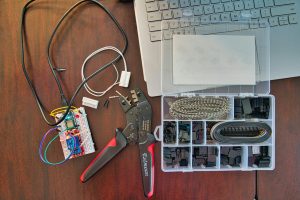
The popularity of the environmentally sustainable laptop market reflects the increase in consumer demand for e-friendly tech.
By introducing sustainable 2024 laptopsmanufacturers are embracing recycled materials, energy-efficient designs, and better recycling programs.
Major players in the market are demonstrating their commitment to sustainability by taking groundbreaking steps in laptop manufacturing.
Look through the practices of sustainable laptop models to shape the industry’s future.
Eco-Friendly Materials Revolutionizing Laptop Manufacturing
There has been substantial progress towards making eco-friendly computers, starting with material selection.
The data shows that tech companies using their e-waste or recycled materials virtually unaffected the resources needed while eliminating the ecological damage from technological developments.
Empowered by the incorporation of more than 1,600 tonnes of post-consumer recycled plastics since 2017, ASUS has instigated this change, exploiting these leftovers to manufacture, thus saving resources and mitigating e-waste accumulation.
Lenovo is another company that excels at incorporating sustainability into its laptop designs. The company’s use of recycled materials helps minimize the environmental impact of its products.
One of Lenovo’s sustainable product lines is the ThinkPad L Series, which utilizes up to 30% post-consumer recycled materials. This shows the importance of ethical sourcing in creating eco-friendly computing solutions.
HP is successful in the same way with ingenious uses of recycled materials. When manufacturing laptops, HP uses recycled post-consumer plastics and collects and reuses ocean-bound plastic waste, taking a holistic approach to sustainable practices by simultaneously reducing pollution and facilitating ocean cleanup measures.
The use of greener materials indicates a pivotal point in electronics manufacturing by laptop producers—a time undoubtedly associated with a substantial rise in environmental preservation within the technology sector.
Through recycled or repurposed elements in their computers, these laptop users practically implement the sustainable development leadership role, not only at present but also in their future, as a world of eco-friendliness meets its place.
Energy Efficiency Standards and Certifications
Credit: Burst on Unsplash
Energy efficiency is crucial to sustainable laptop design. This not only lowers electricity costs but also significantly reduces greenhouse gas emissions.
The ENERGY STAR label is a well-known recommendation for items that exhibit outstanding energy performance.
Devices with this certification have been designed to use less electricity, which reduces their environmental impact.
Obtaining an EPEAT Gold tier becomes another critical target for those whose prime concern is the environment.
Such a label ensures compliance with the rigorous criteria related to power saving and aids in discovering solutions with a minimum ecological impact.
For instance, one of the Lenovo ThinkPad L Series notebooks is known to have a 40% customer reduction in power. They are excellent selections for people who want to reduce their carbon footprint.
ENERGY STAR scored laptops excellently in this area and showed a clear commitment to energy saving.
Consumers who decide on these more efficient machines can reduce their usage and total emissions released into the atmosphere.
Apart from benefiting the environment, owning a laptop of this type allows users to save money over time because of the lower electricity billswhich both people and the planet prefer.
Sustainable Packaging Innovations
Introducing sustainability into laptop packaging will help reduce the environmental degradation caused by manufacturing one gadget.
ASUS has pursued sustainability approaches involving more than 20,000 tonnes of recycled paper for its packaging in just one year, 2022, approaching the mark of more than 90% recycled materials.
This further reduces waste production and is an extremely good example of exciting innovation for the rest of technology companies to replicate and make business greener.
Lenovo’s ThinkPad L Series notebooks, which come in minimalistic yet wholly recyclable boxes, are a great example of Lenovo’s progress on green initiatives.
The company has defined its standpoint of Uniting the Sustainable Future through the initiative.
These valuable contributions are central to the production of less resource-consuming laptops, and thereby, they simultaneously promote a healthier lifestyle among some people.
The Role of Ecolabels in Identifying Sustainable Laptops

Credit: Dell on Unsplash
Ecolabels are a lighthouse for customers wanting an environmentally conscious laptop; Therefore, they act as a guide to sustainability in their shopping.
EPEAT, being in the electronics domain, has developed a specific set of criteria for assessing products based on the ten environmental progressions.
EPEAT has unveiled its three-level system of classification in sustainability for devices: Silver, Bronze, and Gold. Gold certification implies the most extreme eco-friendliness fulfilled by a laptop.
TCO Certification verifies how the environmental impacts of electronic products have been minimized, thus promoting consumers’ eco-consciousness when making a purchase decision.
Greenpeace’s Guide to Greener Electronics provides solid ground for informed choices. It scores manufacturers based on their role in chemical management and serves as a dynamic incentive for using minimally toxic materials.
Certifications like EPEAT and TCO are essential for people who buy eco-friendly laptops.
They assure the quality of the environment and confirm that these computers strictly comply with high environmental standards, which aids customers who care about technological needs and sustainability principles while choosing their laptops.
Long-Lasting Design for Reduced Environmental Impact
Eco-friendly laptop production that lasts is based on criteria such as the strength of the materials and modular construction.
For example, ASUS ensures their laptops can survive the MIL-STD-810H military standard specifications for ruggedness in different situations.
This is precisely how proper resistance to environmental influences causes the materials to stay in good condition, reducing the amount of electrical appliance waste (e-waste).
Sustainable laptop manufacturing implies modularity’s flexibility, which means being able to swap parts such as the keyboard and the battery.
This practice encourages repairability and upgradeability, while reducing the need for new electronic devices achieves environmental sustainability.
Laptops sturdy enough to resist and recover from accidental drops or liquid spills are beneficial because they save consumers from costly repair expenses and increase product lifespan.
Choosing a new laptop designed to be durable and minimize negative environmental impacts improves the individual’s ecological footprint, participating in the transition to environmental integrity.
Recycling Programs and Take-Back Initiatives

Credit: Clint Patterson on Unsplash
Take-back initiatives and recycling procedures are the main methods of reducing the carbon footprint associated with e-waste and improving sustainability.
Dell has been a leader since 2007, recovering over 2.5 billion pounds of electronic devices and demonstrating how useful these programs can be in reducing the swelling of electronic waste.
ASUS is embracing its environmental stewardship and has recycled more than 40,000 tonnes of e-waste since 2019.
Their inclusivity offers free recycling for all branded and non-branded gadgets, making it very easy for consumers to discard their old devices.
Similarly, HP’s supply of complimentary mail-in recycle alternatives applicable to a wide range of electronic equipment helps to support sustainable discarding practices.
Leading retailers like Staples and Best Buy make it possible to recycle old computers and hardware equipment through their programs.
Engaging with them helps with metal recovery and reducing the negative environmental impact of abandoned technology goods.
Recycling one million laptops is enough to secure the energy savings of up to 3,500 American households every year.
Addressing Toxic Chemicals in Laptop Production
The electronics industry has been examined for toxic substances like brominated flame retardants (BFRs) and PVC in manufacturing laptops, which are harmful to health and the environment.
Importantly, these toxic compounds were found in high quantities in several laptop parts, which raises questions about both consumer safety and the environmental footprint.
Faced with this challenge, Apple has emerged as a pioneer by removing BFRs and PVC from its product composition and restricting additional dangerous elements that go beyond what RoHS requirements require. Their approach showcases a remarkable sustainability project in the technology industry.
Lenovo, which removed PVC and BFR from its ThinkPad product line, showcased its environmental leadership.
Dell is a company that faces difficulties yet still manages to avoid these toxic chemicals, which makes it even more successful in carrying on the responsibility for the environment.
Improvement that occurs indiscriminately among all producers is essential; Therefore, the idea of creating a safe ecosystem for technologies by eliminating hazardous agents is worth pursuing.




